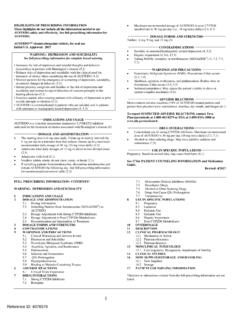Transcription of Molecular Epidemiology and the Prevention of Disease
1 GLOBAL PERSPECTIVES IN HEALTH - Vol. II - Molecular Epidemiology and the Prevention of Disease - Ellen K. Silbergeld Molecular Epidemiology AND THE Prevention OF. Disease . Ellen K. Silbergeld Professor of Epidemiology and Toxicology, University of Maryland Medical School, Baltimore, MD, USA. Keywords: Epidemiology , Molecular Epidemiology , Epidemiologic Methods. Contents 1. Introduction 2. Goals of Epidemiology 3. Epidemiologic Methods S. TE S. 4. Molecular Epidemiology 5. Limits of Molecular Epidemiology R. AP LS. 6. Future Directions in Molecular Epidemiology 7. Conclusion Glossary C EO. Bibliography Biographical Sketch Summary E . H. Recent advances in Molecular biology and genetics offer new tools for understanding PL O.
2 Patterns of health and Disease in human populations. The field of Epidemiology has made major contributions to the identification of preventable causes of human Disease , M SC. but understanding the relationships between risk factors and outcomes has been limited by lack of knowledge of the events that take place between exposure and Disease . In particular, it has been difficult to explain why individuals and populations respond differently to similar risks, such as smoking or chemical exposures. Biomarkers are SA NE. measurable signals of these events, related to exposure and response, as well as inherent susceptibility of individuals and populations. Their use and interpretation depends on our understanding of the underlying biology related the disposition of dose, metabolic U.
3 Transformation of absorbed dose, and cellular response to doses at critical cellular sites of action. New technologies will increase the amount of information available on these parameters, and require advances in our ability to interpret data. 1. Introduction The Prevention of Disease and the promotion of health require the combined expertise and involvement of many clinical and scientific disciplines, integrated into the epidemiological perspective. Epidemiology is the tool of public health, as compared to clinical medicine, since it is the study of health and Disease in populations. Epidemiological studies can be assessments of risks and health at a point in time (cross sectional) or over time (either forward, or prospective, or backward, or retrospective).
4 Epidemiological studies are designed to test the possible associations between one or more exposures or risk factors and health or Disease status, for example, the number of Encyclopedia of Life Support Systems (EOLSS). GLOBAL PERSPECTIVES IN HEALTH - Vol. II - Molecular Epidemiology and the Prevention of Disease - Ellen K. Silbergeld cigarettes smoked per year and lung cancer, or dietary fat intake and blood pressure. It is often difficult to discern whether or not apparent associations are real, or the result of other factors and events that may not be measured or even be measurable in a specific study. Even in complex epidemiological studies, many unrecognized variables can affect associations or obscure the ability to detect true associations.
5 Very few diseases - primarily hereditary diseases such as Huntington's Disease - are associated with only one risk factor. Most diseases are multifactorial in origin, and only a few of the relevant factors may be known at any time. Moreover, human populations are complex groups of individuals, who may vary in many respects (or variables) not wholly knowable by investigators. For example, nutrition is known to influence the response of children to mercury exposures, but accurate nutritional information is difficult to collect without careful monitoring of food selection (duplicate diet studies) or detailed questionnaires on actual food consumption. S. TE S. 2. Goals of Epidemiology R.
6 AP LS. The goal of epidemiological research is to identify causes of Disease and to evaluate the efficacy of interventions to diagnose, treat, cure or prevent Disease (Beaglehole et al C EO. 1993). Investigations, monitoring, observations, and experiments accomplish these goals. Epidemiologists investigate sudden changes in health, such as outbreaks of infectious Disease or poisonings, as well as more gradual changes in the incidence (new cases) or prevalence (existing cases) of Disease . Epidemiologists monitor the health status of populations through surveillance of events such as birth and death statistics or E . through the collection of data on certain diseases, such as AIDS or cancer.
7 H. Epidemiologists design and conduct observational studies on the prevalence and PL O. incidence of diseases in population groups (cohorts) in order to discern risk factors associated with increases in risks or severity of Disease . Epidemiologists conduct M SC. experiments, or clinical trials, to test the efficacy of interventions, such as dietary modification, early medical diagnosis or therapeutic treatment, in eliminating or ameliorating diseases. SA NE. In observational studies, in which exposures and outcomes are assessed as they occur in populations, the challenge of discerning true associations is especially difficult. Precise U. information on exposure may be difficult to define; even within the same job category, individual workers may have different exposures owing to the exact nature of their tasks, the efficacy of worker protection equipment, and personal habits.
8 Even experimental studies can be complicated by unmeasured or unmeasurable variables: in clinical trials, the willingness of patients to participate or continue in a test of a therapeutic may reflect variables that also affect health, such as education and economic status in trials of dietary modification in preventing heart Disease . 3. Epidemiological Methods To minimize these complications, epidemiological research has relied on rigorous methods to design studies and analyze data, and to avoid the introduction of unintended bias into research. In experimental studies, to separate the effects of treatment from other influences, epidemiologists generally utilize a rigorous procedure of Encyclopedia of Life Support Systems (EOLSS).
9 GLOBAL PERSPECTIVES IN HEALTH - Vol. II - Molecular Epidemiology and the Prevention of Disease - Ellen K. Silbergeld randomization to minimize the impact of undetected differences between persons treated and untreated in a clinical trial. In observational studies, where the goal is to understand factors influencing health status among populations without the opportunity to control exposures or to preselect subjects, epidemiologists generally use one of two types of study designs: a case: control design, in which persons with a particular Disease are matched with persons who do not have the Disease , and the frequency or levels of exposure to the hypothesized risk factor are measured in each group.
10 If the exposure is more frequent, or greater, in the population with the Disease (cases), as compared to the controls, then an association is deemed to exist between the exposure and the outcome. The other type of study is a cohort study, in which two groups are selected based upon exposure. They may be evaluated at one point in time (cross sectional study); they may be followed in time to determine the eventual outcomes of exposure (prospective study), or their medical history may be evaluated (retrospective study). If the incidence or prevalence of Disease is significantly greater in the exposed group as compared to unexposed groups, then an association may exist between the exposure and the S.














